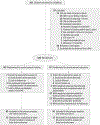Effect of parent training vs parent education on behavioral problems in children with autism spectrum disorder: a randomized clinical trial
- PMID: 25898050
- PMCID: PMC9078140
- DOI: 10.1001/jama.2015.3150
Effect of parent training vs parent education on behavioral problems in children with autism spectrum disorder: a randomized clinical trial
Erratum in
-
Baseline Data Incorrect.JAMA. 2016 Jul 19;316(3):350. doi: 10.1001/jama.2016.9050. JAMA. 2016. PMID: 27434459 No abstract available.
-
Misspelled Author Name.JAMA. 2016 Jul 19;316(3):350. doi: 10.1001/jama.2016.9558. JAMA. 2016. PMID: 27434460 No abstract available.
Abstract
Importance: Disruptive behavior is common in children with autism spectrum disorder. Behavioral interventions are used to treat disruptive behavior but have not been evaluated in large-scale randomized trials.
Objective: To evaluate the efficacy of parent training for children with autism spectrum disorder and disruptive behavior.
Design, setting, and participants: This 24-week randomized trial compared parent training (n = 89) to parent education (n = 91) at 6 centers (Emory University, Indiana University, Ohio State University, University of Pittsburgh, University of Rochester, Yale University). We screened 267 children; 180 children (aged 3-7 years) with autism spectrum disorder and disruptive behaviors were randomly assigned (86% white, 88% male) between September 2010 and February 2014.
Interventions: Parent training (11 core, 2 optional sessions; 2 telephone boosters; 2 home visits) provided specific strategies to manage disruptive behavior. Parent education (12 core sessions, 1 home visit) provided information about autism but no behavior management strategies.
Main outcomes and measures: Parents rated disruptive behavior and noncompliance on co-primary outcomes: the Aberrant Behavior Checklist-Irritability subscale (range, 0-45) and the Home Situations Questionnaire-Autism Spectrum Disorder (range, 0-9). On both measures, higher scores indicate greater severity and a 25% reduction indicates clinical improvement. A clinician blind to treatment assignment rated the Improvement scale of the Clinical Global Impression (range, 1-7), a secondary outcome, with a positive response less than 3.
Results: At week 24, the Aberrant Behavior Checklist-Irritability subscale declined 47.7% in parent training (from 23.7 to 12.4) compared with 31.8% for parent education (23.9 to 16.3) (treatment effect, -3.9; 95% CI, -6.2 to -1.7; P < .001, standardized effect size = 0.62). The Home Situations Questionnaire-Autism Spectrum Disorder declined 55% (from 4.0 to 1.8) compared with 34.2% in parent education (3.8 to 2.5) (treatment effect, -0.7; 95% CI, -1.1 to -0.3; P < .001, standardized effect size = 0.45). Neither measure met the prespecified minimal clinically important difference. The proportions with a positive response on the Clinical Global Impression-Improvement scale were 68.5% for parent training vs 39.6% for parent education (P < .001).
Conclusions and relevance: For children with autism spectrum disorder, a 24-week parent training program was superior to parent education for reducing disruptive behavior on parent-reported outcomes, although the clinical significance of the improvement is unclear. The rate of positive response judged by a blinded clinician was greater for parent training vs parent education.
Trial registration: clinicaltrials.gov Identifier: NCT01233414.
Conflict of interest statement
Figures



Comment in
-
Promising forecast for autism spectrum disorders.JAMA. 2015 Apr 21;313(15):1518-9. doi: 10.1001/jama.2015.2628. JAMA. 2015. PMID: 25898047 No abstract available.
References
-
- American Psychiatric Association. Diagnostic and Statistical Manual of Mental Disorders. 5th ed. Washington, DC: American Psychiatric Association; 2013.
-
- Mazurek MO, Kanne SM, Wodka EL. Physical aggression in children and adolescents with autism spectrum disorders. Res Autism Spectr Disord. 2013; 7:455–465.
-
- Maskey M, Warnell F, Parr JR, Le Couteur A, McConachie H. Emotional and behavioural problems in children with autism spectrum disorder. J Autism Dev Disord. 2013;43(4):851–859. - PubMed
Publication types
MeSH terms
Associated data
Grants and funding
- MH079130/MH/NIMH NIH HHS/United States
- R01 MH080965/MH/NIMH NIH HHS/United States
- KL2 RR024138/RR/NCRR NIH HHS/United States
- R01 MH081105/MH/NIMH NIH HHS/United States
- R01 MH080906/MH/NIMH NIH HHS/United States
- R01 MH081221/MH/NIMH NIH HHS/United States
- R01 MH081148/MH/NIMH NIH HHS/United States
- MH080906/MH/NIMH NIH HHS/United States
- MH081221/MH/NIMH NIH HHS/United States
- MH081105/MH/NIMH NIH HHS/United States
- U54 MH066397/MH/NIMH NIH HHS/United States
- UL1 RR024139/RR/NCRR NIH HHS/United States
- MH080965/MH/NIMH NIH HHS/United States
- UL1 TR000042/TR/NCATS NIH HHS/United States
- MH081148/MH/NIMH NIH HHS/United States
- 5KL2RR024138/RR/NCRR NIH HHS/United States
- K01 MH079130/MH/NIMH NIH HHS/United States
- UL1 RR025008/RR/NCRR NIH HHS/United States
LinkOut - more resources
Full Text Sources
Medical
Miscellaneous

